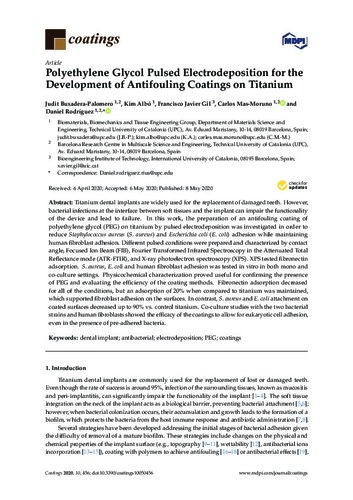Mostra el registre d'ítem simple
Polyethylene glycol pulsed electrodeposition for the development of antifouling coatings on titanium
| dc.contributor.author | Buxadera Palomero, Judit |
| dc.contributor.author | Albo Selma, Kim |
| dc.contributor.author | Gil Mur, Javier |
| dc.contributor.author | Mas Moruno, Carlos |
| dc.contributor.author | Rodríguez Rius, Daniel |
| dc.contributor.other | Universitat Politècnica de Catalunya. Departament de Ciència i Enginyeria de Materials |
| dc.date.accessioned | 2020-10-27T09:13:30Z |
| dc.date.available | 2020-10-27T09:13:30Z |
| dc.date.issued | 2020-05-01 |
| dc.identifier.citation | Buxadera-Palomero, J. [et al.]. Polyethylene glycol pulsed electrodeposition for the development of antifouling coatings on titanium. "Coatings", 1 Maig 2020, vol. 10, núm. 5, p. 456/1-456/17. |
| dc.identifier.issn | 2079-6412 |
| dc.identifier.uri | http://hdl.handle.net/2117/330850 |
| dc.description.abstract | Titanium dental implants are widely used for the replacement of damaged teeth. However, bacterial infections at the interface between soft tissues and the implant can impair the functionality of the device and lead to failure. In this work, the preparation of an antifouling coating of polyethylene glycol (PEG) on titanium by pulsed electrodeposition was investigated in order to reduce Staphylococcus aureus (S. aureus) and Escherichia coli (E. coli) adhesion while maintaining human fibroblast adhesion. Different pulsed conditions were prepared and characterized by contact angle, Focused Ion Beam (FIB), Fourier Transformed Infrared Spectroscopy in the Attenuated Total Reflectance mode (ATR-FTIR), and X-ray photoelectron spectroscopy (XPS). XPS tested fibronectin adsorption. S. aureus, E. coli and human fibroblast adhesion was tested in vitro in both mono and co-culture settings. Physicochemical characterization proved useful for confirming the presence of PEG and evaluating the efficiency of the coating methods. Fibronectin adsorption decreased for all of the conditions, but an adsorption of 20% when compared to titanium was maintained, which supported fibroblast adhesion on the surfaces. In contrast, S. aureus and E. coli attachment on coated surfaces decreased up to 90% vs. control titanium. Co-culture studies with the two bacterial strains and human fibroblasts showed the efficacy of the coatings to allow for eukaryotic cell adhesion, even in the presence of pre-adhered bacteria. |
| dc.language.iso | eng |
| dc.publisher | Multidisciplinary Digital Publishing Institute (MDPI) |
| dc.rights | Attribution-NonCommercial-NoDerivs 3.0 Spain |
| dc.rights.uri | http://creativecommons.org/licenses/by-nc-nd/3.0/es/ |
| dc.subject | Àrees temàtiques de la UPC::Enginyeria dels materials |
| dc.subject.lcsh | Dental implants |
| dc.subject.lcsh | Biomedical materials |
| dc.subject.other | Dental implant |
| dc.subject.other | Antibacterial |
| dc.subject.other | Electrodeposition |
| dc.subject.other | PEG |
| dc.subject.other | Coatings |
| dc.title | Polyethylene glycol pulsed electrodeposition for the development of antifouling coatings on titanium |
| dc.type | Article |
| dc.subject.lemac | Implants dentals |
| dc.subject.lemac | Materials biomèdics |
| dc.contributor.group | Universitat Politècnica de Catalunya. BBT - Biomaterials, Biomecànica i Enginyeria de Teixits |
| dc.identifier.doi | 10.3390/COATINGS10050456 |
| dc.description.peerreviewed | Peer Reviewed |
| dc.relation.publisherversion | https://www.mdpi.com/2079-6412/10/5/456 |
| dc.rights.access | Open Access |
| local.identifier.drac | 29004366 |
| dc.description.version | Postprint (published version) |
| dc.contributor.covenantee | Universitat Internacional de Catalunya |
| local.citation.author | Buxadera-Palomero, J.; Albo, K.; Gil, J.; Mas-Moruno, C.; Rodriguez, D. |
| local.citation.publicationName | Coatings |
| local.citation.volume | 10 |
| local.citation.number | 5 |
| local.citation.startingPage | 456/1 |
| local.citation.endingPage | 456/17 |
Fitxers d'aquest items
Aquest ítem apareix a les col·leccions següents
-
Articles de revista [734]
-
Articles de revista [439]


